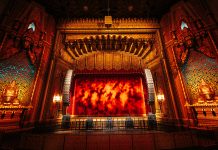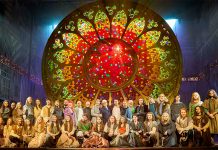The theatre program at Carroll College in Helena, Montana, has been producing wonderful productions for the last 35 years, in spite of entertainment technology that is at least that old. The program recently updated their 120-seat FLEX Theatre with a state-of-the-art, energy-efficient Elation Professional LED lighting system that opens up all new possibilities for student creativity in the new theatre space.
Formerly housed in an old gymnasium with a lighting rig made up of antiquated Fresnels, scoops, ellipsoidals and even a few homemade fixtures, the theatre department’s move to a new location in 2016 gave the program the opportunity to leave the old equipment behind and reimagine the space using new technology.
Riverhaus Design Group (riverhausdesign.com), a multi-discipline design practice and theatre consultancy firm, was contacted to design the lighting system for the new space. “Through interviews with the faculty and hands-on auditions at the USITT conference with faculty and students, the design team selected a full complement of Elation fixtures,” said Jason DeCunzo, Executive Director at Riverhaus Design Group. “Each selection was made based on performance, ease of use and quality of projected light.”
The FLEX Theatre’s new lighting system consists exclusively of Elation luminaires: 20 Colour Pendant™ LED colour-changing downlights, 18 WW Profile™ warm-white ellipsoidal spots, 18 Colour 5 Profile™ LED colour-changing ellipsoidal spots, 5 TVL CYC RGBW™ cyclorama wall wash lights, and 5 Arena PAR Zoom™ LED wash lights. “The combination of colour-mixing luminaires and warm white fixtures allows the department to utilise stock gels, as well as create any other colour in combination,” DeCunzo says. “This provides a unique educational opportunity to work with light in a more traditional way, as well as provide endless combinations of colour mixing and effects. Additionally, the warm white fixtures provide a very true and natural 3050 kelvin output, so audiences are instantly connected to the light, without the color shifts sometimes present when ‘all solid-state’ lighting is employed.”
The TVL CYC RGBW fixtures with their COB LEDs and the Arena PAR Zooms with their QUAD Color LEDs provide a great variety of blended floods of color. “The use of TVLs provides expansive, gorgeous color washes that easily morph over timed queues from one color to the next in very smooth transitions, and the Arena PAR Zooms provide opportunities to go from a wide stage wash to a very small spot in one smooth step, providing a level of dynamics that haven’t been experienced by audiences here,” DeCunzo states. Of the downlighting Colour Pendant fixtures, he said, “The Color Pendant is one of my most favorite luminaires. It’s powerful, quiet, and combines the functions of house light and color wash. This was critical for the Flex Theatre because we had to do more with less. Even for the first production, these fixtures pulled double-duty as house lights, as well as full-theatre color washes to help create sunrise and sunset effects, as well as enhance fantasy sequences that enveloped the whole audience.”
DeCunzo names several characteristics of the new lighting system that were important to realize. For one, a lighting system that includes moving as well as static fixtures was a priority. “It’s so easy to discount moving heads in a live, traditional theatre environment because they are often used just as ‘eye candy’ or for a flashy effect,” he says. “I wanted to make sure that we included some automated features so that the students see what’s possible, and employ technology in a way that pushes them to think outside the box. The more tools they have to use, the more they can exercise their imaginations.” The ability to get a familiar and natural warm white colour from the fixtures, while at the same time mixing colour that felt organic, was also important. “Colour-matching and trueness is important to me because without it the audience can see the slight differences from fixture to fixture, pulling their attention away from the story being told on stage.”
The new theatre is not large but completely variable in its configuration. The grid is only 16’ above floor level but it extends across the entire space, including anywhere that the audience might be placed for a particular production. DeCunzo says that focused his attention on the actual projection angles possible within the space and then to find the right tools to accomplish the most desirable outcome. That meant it was important that colors and output be accurate from fixture to fixture, and that fixtures were relatively quiet during operation, as some of them can be as close as 4 feet away from an audience member’s head.
They also wanted to get the most out of the fewest number of luminaires so that the grid didn’t get too crowded. DeCunzo comments, “I’m sure we’ve all been in a ‘black box’ theatre that hinders the audience experience because the equipment is either too loud or visually gets in the way. Elation fixtures met all of these goals for the Flex Theatre, and provided the added benefit of not requiring a single traditional dimmer to be employed.”
Contemplating the changes that a move to an all LED rig would bring, the designer shares an anecdote about the benefits of using LED fixtures. “At one point during my presentation of the initial theatre design, the Head of Technical Theatre suddenly looked up from the table of drawings, raised his eyebrows, and said ‘Wait! Oh no! We’ve forgotten to include the dimmer rack!’ I quickly explained that we don’t need them because we didn’t have one single ‘conventional’ fixture in the design. It took a few seconds for that to sink in, but we then all had a good chuckle about it. It was the first time in 40 years that he’d ever thought about lighting a production without having to consider the dimmer loads, heat gain, and other associated issues.”
A more intelligent lighting rig opens up for more opportunity for creativity in design. DeCunzo wanted the students at Carroll College to be allowed to imagine “what if” and not be encumbered by a lack of features or workable space. “Moving from a very traditional proscenium stage with raked auditoria to a completely flexible theatre that allows any configuration required that the lighting be extremely flexible in placement and operation,” he said. “With this complement of Elation fixtures, the combinations are now almost endless, and the students have already begun to learn new techniques and think differently about how lighting can shape their productions.”
The difference between the old space and new is quite dramatic and the theatre turned out beautifully, DeCunzo says. He thanks the faculty of Carroll College for allowing him the honour of leading the design process for their new theatre and specifically thanks Kimberly Shire, Director of Theatre Arts; Chuck Driscoll, Head of Technical Theatre; Nancy Harper, Costume Head; and Tom McCarvel, VP Community Relations and Facilities. “These folks are inspiring, and really created a new opportunity for their college, their students and the Helena community.”
“I’m just so impressed with the Elation arsenal of luminaires,” the designer concludes. “The equipment has provided so much more opportunity for lighting design and the types of shows and events that can take place here. The technical theatre program has even received donations from patrons because of how much the production value has improved – in only a few months. The capability of the new theatre is now a serious topic of pride for Carroll College.” The Flex Theatre’s new lighting system was completed in October 2016 and debuted a month later on a production of “The 25th Annual Putnam County Spelling Bee.”
www.elationlighting.com






